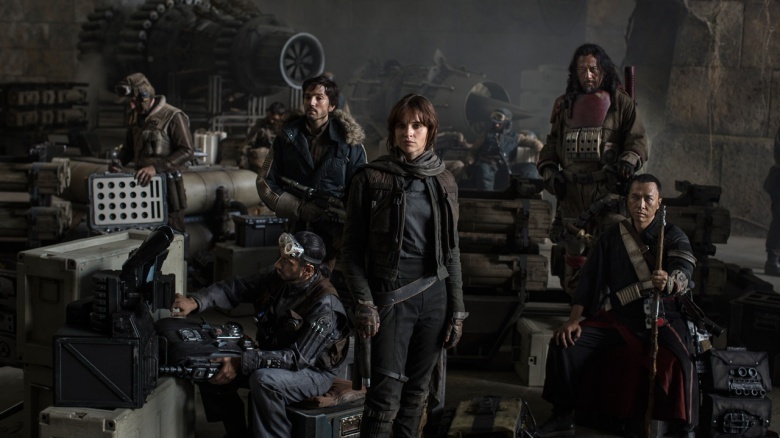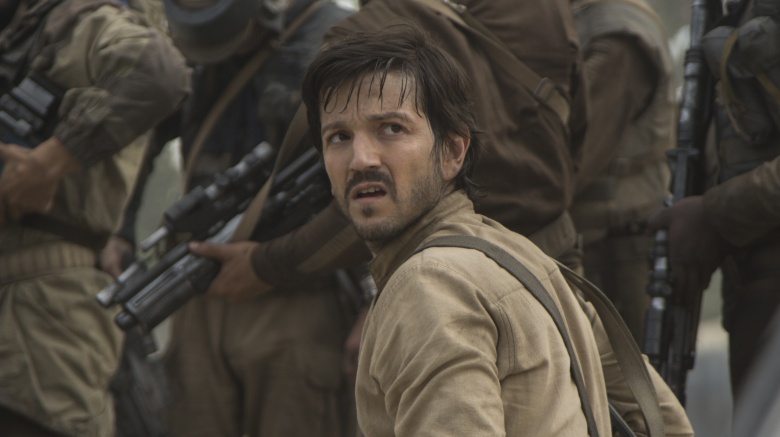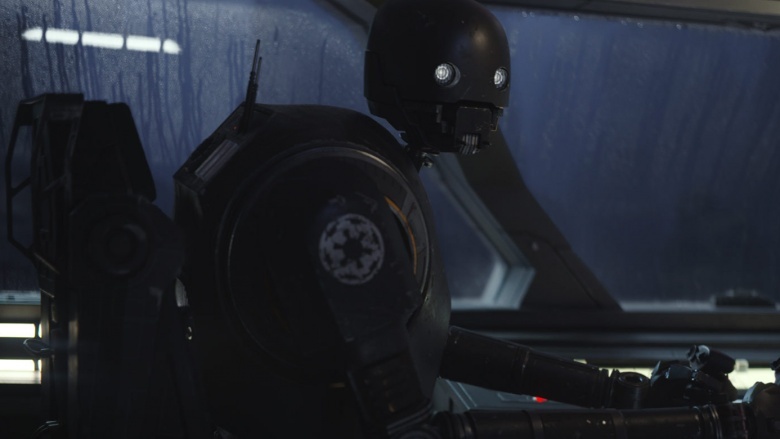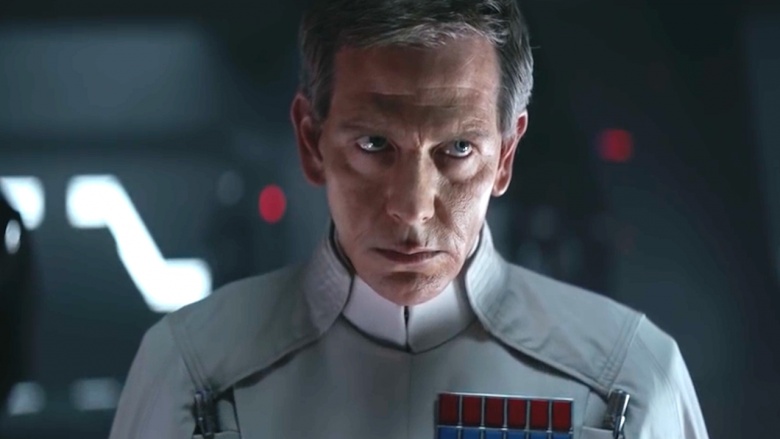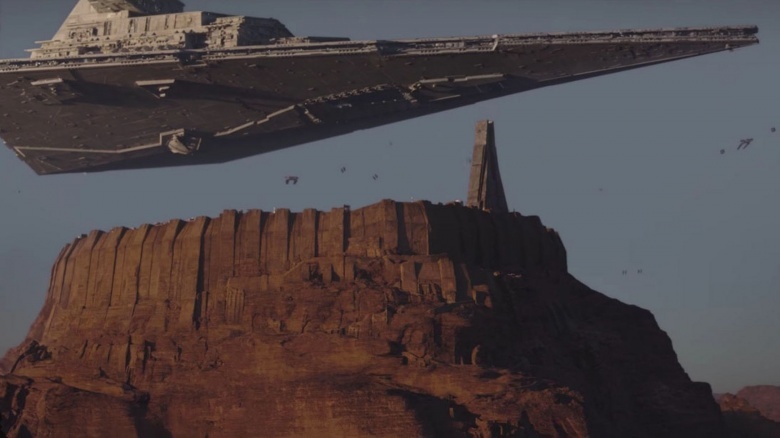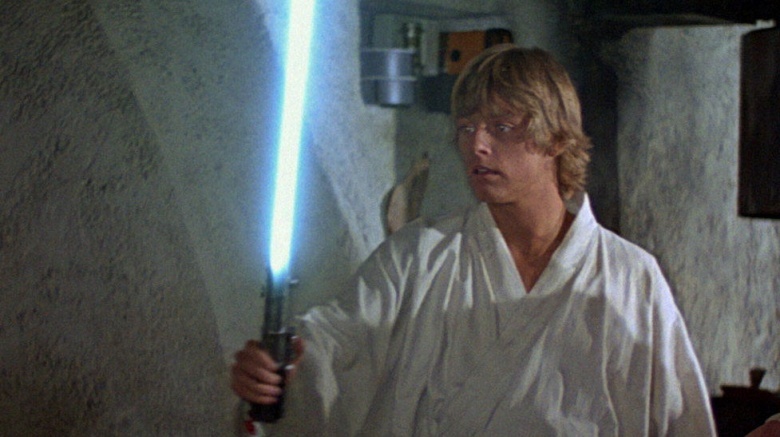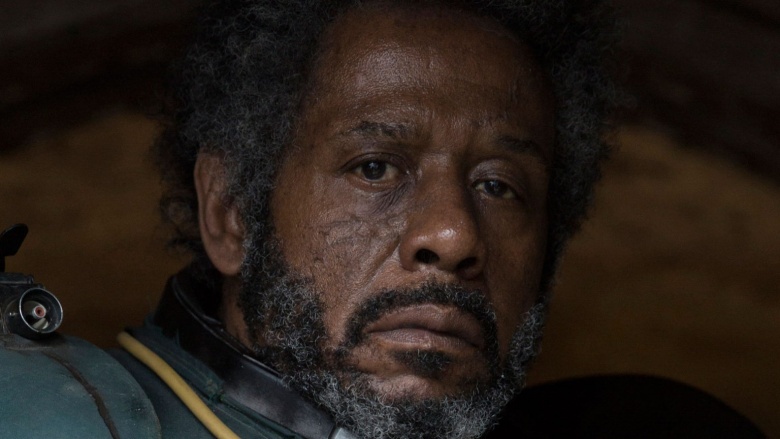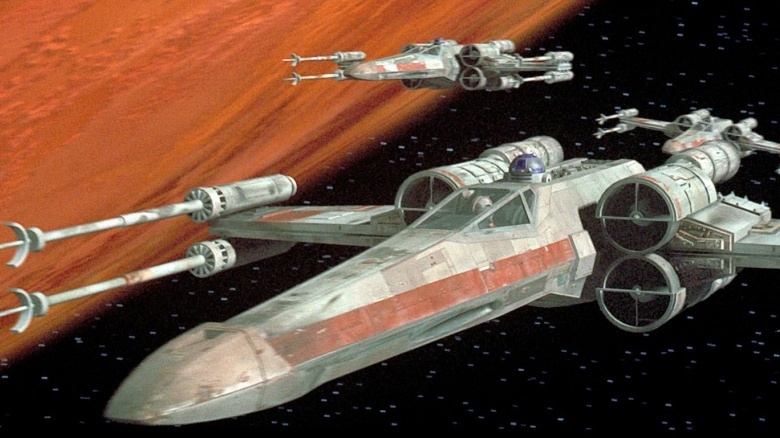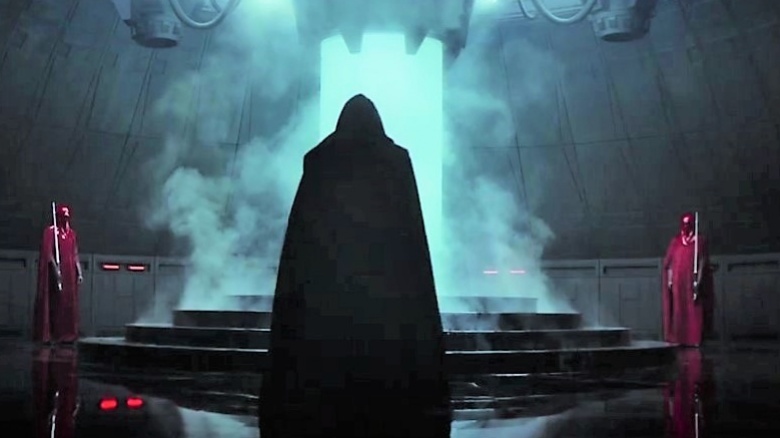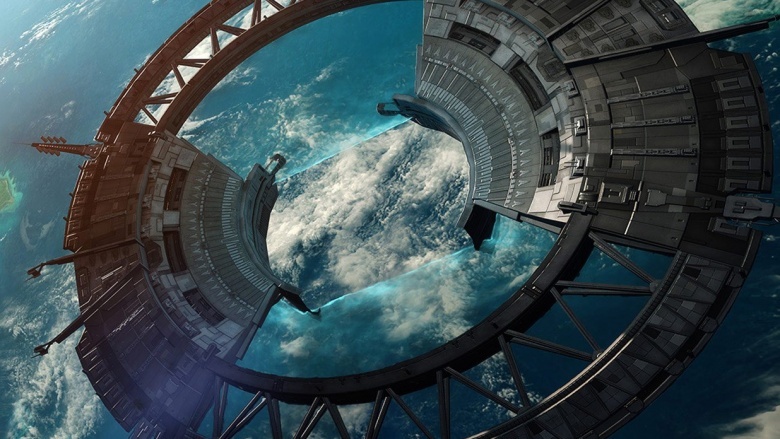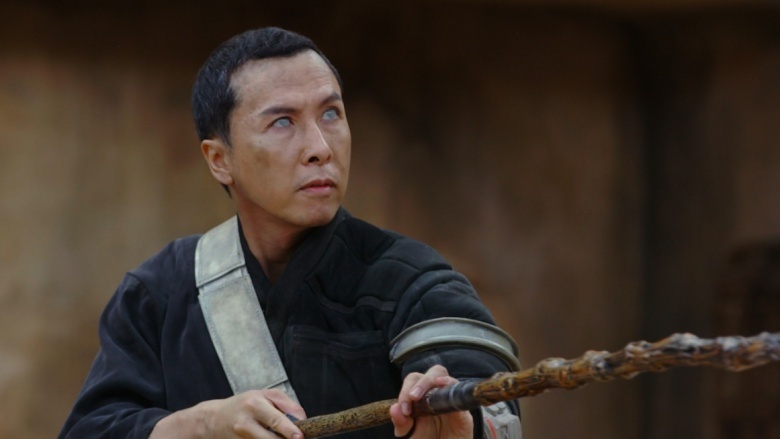Surprising Ways Rogue One Sets Up The Original Star Wars Trilogy
As a direct prequel to Star Wars: A New Hope, there are many obvious ways that Rogue One sets up the original trilogy. For instance, it explains why the Death Star has has such a weakness (turns out the lead designer hated the Empire) and how the Rebels actually stole the plans. However, there are a number of hidden and otherwise surprising ways that the movie leads into the original films. Beware, though: just as you encounter your inner demons in Yoda's cave, there are nothing but Rogue One spoilers ahead.
Murky morality
During a famously funny scene in Kevin Smith's Clerks, the two main characters debate the morality of the Rebels in the original Star Wars trilogy. One character, Randall, opines that their willingness to destroy the half-built second Death Star essentially betrays their alleged politics because they're willing to kill the assorted innocent civilian contractors and non-Imperial personnel who were involved with the project.
This argument has always orbited the very notion of Star Wars. The heroes are armed insurgents who fight against the legitimate government, and while "Rebels" is one word that describes that idea, the other word is "terrorists." This has always seemed at odds, though, with the main characters who engage in one-on-one duels with the enemy and thrust themselves into impossible odds. All of this leaves the astute fan to wonder how they reconcile the seemingly bloody terrorist actions of the Rebels with the actions of characters like Luke Skywalker.
Rogue One presents a simple answer to that question in the form of Captain Cassian Andor, a Rebel intelligence agent who often gets his hands dirty—sometimes by shooting nervous informants, and other times by indiscriminately shooting both parties in a firefight. And, of course, he's not above taking on an assassination mission. He explicates his arc as one of redemption, as he wants all of the shady things he has done for the Rebellion to be worth it. This character's existence confirms that the success of heroic and noble Rebels like Luke and Leia depends on countless Captain Andors who engage in murder, assassination, and...well...terrorism. This may also help explain why star systems aren't exactly jumping to join the Rebels early on—not only would they fear being crushed by the Empire, but the Rebels are clearly willing to kill in order to accomplish their goals.
The lack of Imperial droids
Quick: what's the first thing you think of when you hear the words "Imperial droid?" Chances are, you thought of either the cool Probe Droid from Empire Strikes Back or that weird mouse droid from A New Hope. This seems in stark contrast to the Rebels, who include at least one droid in every ship and seem to rely heavily on protocol and astromech droids for a variety of activities that go far beyond their job descriptions. When you stop to think about it, this is actually a little weird, because the Empire has enough money and other resources to manufacture droids that would be helpful with every aspect of fighting the Rebellion.
Rogue One fills the gap with K-2SO, an Imperial droid stolen and reprogrammed by the Rebellion, where he's ultimately used as a sort of one-robot army. He can hack any droid, hack any system, and once they finally give him a blaster, he wipes out countless stormtroopers before being taken down. Why did the Empire stop relying on droids? Maybe because they were practically handing the Rebellion a mechanical army ripe for the hijacking. Remember that Probe Droid from Empire Strikes Back? It self-destructs after it's fired upon. It's clear that the Empire learns its lesson from K-2SO, and isn't willing to give the Rebels any additional weapons.
Imperial infighting
There's a scene in A New Hope that is, in retrospect, unlike any other in the original trilogy. Aboard the Death Star, various Imperial leaders discuss what to do with the Death Star, and they all have different agendas. To put it less delicately, they downright bicker: General Tagge is worried that the Death Star genuinely does have a weakness, Admiral Motti wants to blow stuff up, and Darth Vader just wants to choke the arrogance out of Motti, all while Grand Moff Tarkin tries to keep everything in order. In a movie filled with laser swords and magic powers, this scene looks damn realistic, with the different agendas of various characters coming to a head all at once.
In Rogue One, the bitter back-and-forth between Director Krennic and the Uncanny Valley CGI of Grand Moff Tarkin helps to foreshadow this nicely. Tarkin is eager to blame every error on Krennic's incompetence, while Krennic the career man is just worried about keeping control of the project...so worried that he even steps on Vader's toes. Not only does this foreshadow the bickering in A New Hope, but it arguably foreshadows the future fall of the Empire. In that same scene in A New Hope, Tarkin casually mentions how the Emperor has dissolved the Senate and now "The Moffs and the Grand Moffs will now have direct control over their systems." When questioned about how the Empire would maintain control, Tarkin simply asserts that "Fear will keep the local systems in line. Fear of this battle station." It seems the Emperor gambled on the Death Star alone helping rein in these different military fiefdoms, and the loss of the battle station meant that every leader wanted to go in a different direction...something both dramatized and foreshadowed by Krennic and Tarkin.
The Force as religion
There is an interesting aspect of the Force in the original trilogy that's often overlooked because of how buried it is: the Force functions as an actual religion for many people. It's easy to think of the Force as nothing more than a tool used by those who have enough sensitivity to use it. However, there's an enticing throwaway line in A New Hope about this subject: when Admiral Motti is trash-talking Vader, he refers to the Force as "sorcerer's ways" and mocks Vader's "sad devotion to that ancient religion." In Rogue One, those religious aspects are in full Force (so to speak).
Audiences see a Jedi Temple, allegedly the last of its kind (which helps explain why Luke had to go to the middle of nowhere to find one before the events of Force Awakens). This temple is guarded by monks and others who are not themselves Force-sensitive, but nonetheless "pray" to the Force. This is most evident in the character of Chirrut Îmwe, who often prays by repeatedly saying "I am one with the Force, the Force is with me." Jyn Erso's family gives her a necklace that seems to be made of a kyber crystal, effectively making it a religious relic. All of this helps support the Force as a true religion that spans the galaxy. Ultimately, this makes sense, as even the most powerful political and military leaders in the original trilogy seemed concerned with Luke Skywalker. This makes little sense if you imagine him as only "gifted new Rebel recruit." However, if Luke is the sole embodiment of a major religion for the Rebels, he suddenly becomes a bit of a Jesus figure and all of the attention makes sense. It's too bad his dad already played the "immaculate conception" card for the family, huh?
The rarity of lightsabers
There's another hidden truth about Star Wars lurking in the original trilogy—the idea that lightsabers are apparently very, very rare. Sure, it makes sense that these are primarily weapons used by the Jedi who have the training to deflect blasters and whatnot. However, plenty of people seem to fight the Empire by using various staffs and batons. Imagine the damage a lightsaber could do...and, as Han Solo and one really dead tauntaun can attest, it doesn't take a Jedi to use one. What, then, happened to the lightsabers?
Rogue One explains that kyber crystals are used to power lightsabers. It seems the Jedi historically guarded those crystals within their temples (or, alternately, built the temples around the crystals), and the Empire is seen in this movie strip mining the last Jedi temple for all of the available crystals, all of which are necessary for the Death Star. Soon after, this allegedly last temple is destroyed as a demonstration of the Death Star's power. Therefore, it would be extraordinarily difficult for even a Jedi to build a new lightsaber, much less an average Joe.
Rebel unification
The other notable thing about the Rebels as a ragtag (and arguably terrorist) organization is how unified they seemed to be throughout the original trilogy. In reality, this should be a collection of different cells, all of whom have their own goals and motivations. It seems likely that they would bicker and clash more often than they'd play nice and get along, so what happened? It turns out that Rogue One helps explain this, too.
Forest Whitaker plays Saw Gerrera, a militant rebel extremist who isn't afraid to torture and kill to accomplish his goals. He's apparently too extreme even for the murky morality of the mainstream Rebels, which helps seal his city's fate as a Death Star test site. What does this mean for the original trilogy? In all likelihood, the Empire was focusing most of its military attention towards the loudest and most militant Rebel targets. Saw's character, for instance, stands in deliberate contrast to the assembled Council that can't decide whether they want to fight when they first assemble. In their own bizarre way, the Empire helped to unify the Rebels by destroying anyone with a competing ideology and then capping that off by threatening entire planets. With their backs to the wall, the same Rebels who would be hesitant to actually fight the Empire are forced to band together for mutual protection. This ultimately validates Leia's claim that Tarkin tightening his grip would actually lead to more Imperial-controlled systems and people joining the Rebellion.
The X-wing as the primary Rebel fighter
Without a doubt, Rogue One solidifies the X-wing as the Rebellion's small starfighter weapon of choice. While Y-wings play a major role in the space battle at the end, the X-wings are instrumental in helping the heroes save the day. While X-wings were arguably the main ships in A New Hope as well, the other canonical media close to this timeframe in the Star Wars story is the cartoon Rebels. That show makes it clear that, early on, the Rebellion was primarily relying on ships like B-wings, A-wings and Y-wings in order to fight the Empire's TIE fighters.
Rogue One helps to cement the X-wings as the primary fighters by not only featuring quite a few of them, but also featuring some familiar faces such as Red Leader. His Red Squadron features prominently in the movie, although there seems to be a high turnover rate, as several pilots die. One of them uses Luke Skywalker's future callsign, "Red Five." This helps to establish something else fans were always curious about: how quickly Luke gets hired by the Rebellion for a critical military operation. Watching several members of Red Squadron die immediately before the events of A New Hope helps establish the brutal truth that there were quite a few job openings for Luke to potentially fill.
Vader's hidden weakness
When Vader appears in A New Hope, he seems utterly inhuman, aside from those periodic rages in which he uses his magical powers to choke the life out of people pissing him off. In Empire Strikes Back, it's actually a shock for first-time viewers to see a glimpse of Vader's scarred and bald head before the helmet fully descends. This slow tease reaches its climax in Return of the Jedi, in which Vader's helmet is taken completely off and he is revealed as a sad and broken man (or, in the immortal words of Chasing Amy's Hooper X, "a feeble, crusty old white man!").
Rogue One helps establish Vader's humanity—and his weakness. He's first glimpsed in his castle—apparently built on Mustafar, the same planet where he received his horrific burns in the first place. Rather than his familiar armor, he's revealed in the familiar Star Wars bacta tank. This helps establish Vader as having his own scars and weaknesses, but it also offers interesting parallels to his son, who's healed by a bacta tank in Empire Strikes Back. Vader, of course, is unable to ever heal his body, and can't truly be whole until Luke lures him back to the Light Side.
Shield Generators for Planets
Rogue One sets up yet another vitally important aspect of both Empire Strikes Back and Return of the Jedi: planetary shields. In Rogue One, the Rebel fleet has to take out a shield protecting Scarif before Jyn Erso and her crew can transmit the stolen Death Star plans. As plots go, it's pretty straightforward, but it does set up the kind of shielding seen in later movies. For instance, while the Empire and their big budget can afford shields that cover all of Scarif and, later, all of the second Death Star, the Rebels could only afford a partial shield to protect their base on Hoth. It was enough to prevent the Empire from simply blowing the Rebel base up from orbit, but it didn't keep them from dropping their AT-AT walkers on the planet. It's notable that the Rebels keep the shield generator on the planet, just as the Empire would later keep the Death Star's shield generator on Endor. Apparently, both sides learned the folly of having a shield generator hovering in orbit after the fleet in Rogue One destroys Scarif's shields.
The Force literally protects people
The original Star Wars trilogy was based on serial adventure stories like Flash Gordon—and much like those serials, Star Wars features heroes who often escape seemingly certain death. This includes Luke Skywalker surviving blasts to his X-wing that would have killed other pilots, Han and Leia escaping two Star Destroyers and their TIE Fighters, Lando escaping the Death Star explosion that claims almost every other pilot's life—heck, a First Order Stormtrooper misses a clean shot on Rey while she's literally standing still in Force Awakens. Sometimes there are in-universe explanations for this (such as the stormtroopers on the first Death Star presumably playing along with Vader's plan to let the Rebels go), but the most common explanation is simply "plot armor." These are the heroes and, more often than not, they survive because the script says so.
Rogue One presents an interesting third explanation, though: the Force can, at times, literally protect people. Typically, the protection of the Force is presented as more of a general and mystical thing...sort a religious invocation, as "may the force be with you" is often equivalent to "May God protect you." Rogue One, though, presents the Force-attuned Chirrut Îmwe repeatedly muttering his Force prayer and slowly walking through a battlefield. The movie certainly seems to imply that the Force, which flows through all living things, is throwing off the aim of the stormtroopers firing at him. That would help explain the number of times that the heroes of the original trilogy narrowly escape death, and adds an interesting wrinkle to the prequels as well. Why use a droid army at all? It's entirely possible Palpatine wanted to deliberately use droids to whittle down the Jedi because the Force doesn't flow through droids and can't throw off their aim.
